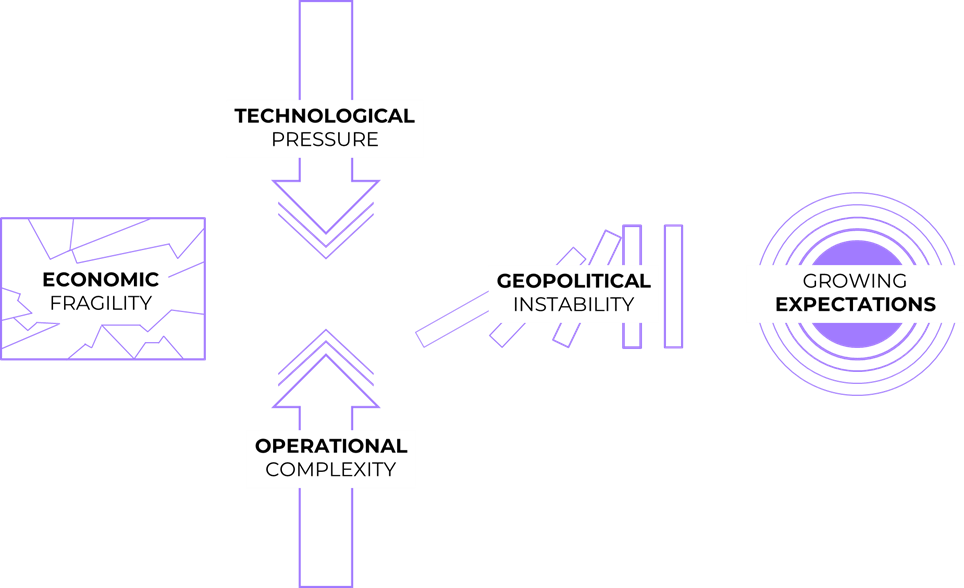
In an increasingly complex and volatilebusiness environment, operational excellence remains a strategic priority fororganizations across industries. Yet, the nature of this pursuit has changeddramatically. Traditional methods based on standardization and incrementalimprovement are no longer sufficient to manage the speed, scale, andinterdependence of modern operations.
How to drive excellence, then? Let’s startwith the foundations.
The Hidden Backbone of Every Business
Every business runs on processes.
They may be invisible, but they are the true backbone of operations, shapinghow a company purchases, delivers, serves, and grows. Every invoice,installation, or payment follows a predefined path; one that often spansmultiple teams, systems, and even countries. These flows of activities are thelifeblood of every organization, silently driving its performance anddetermining how value is created, transferred, and perceived.
Processes are therefore not justoperational routines: they are the critical lever for innovation andimprovement, as they directly affect a company’s results and resilience. They determine how quickly an organization can respond to customerneeds, how effectively it can integrate new technologies, and how efficientlyit can scale without sacrificing quality or compliance.
Yet, processes are rarely simple. Overtime, they evolve organically rather than by design, adapting to new systems,regulations, and customer demands. They intertwine, overlap, and accumulateinefficiencies: manual workarounds that become permanent, unnecessary reworksthat inflate costs, bottlenecks that slow delivery, and deviations that createinconsistencies across regions or teams.

The result is a layer of operationalcomplexity that hides beneath the surface. Decisions become harder to make,visibility decreases, and accountability gets diluted. Even organizations thatheavily invest in technology and digital transformation find themselvesconstrained by outdated ways of working.
Understanding and managing these hiddendynamics is therefore essential. Every process tells a story, not only aboutefficiency, but also about organizational behavior, governance, andcollaboration. To transform performance, companies must first learn to readthose stories clearly.
When External Pressure Meets InternalComplexity
The challenges businesses face today arenot limited to what happens inside their walls. Economic instability,geopolitical tension, and shifting customer expectations all amplify the pressureon operations.
On one side, companies are urged toinnovate fast: adopting AI, automation, and advanced analytics to stayrelevant. On the other, they face a growing tangle of technologies, tools, andsystems that make their operational landscapes more complex than ever.
In many organizations, growth has come withfragmentation. Multiple ERP instances, legacy systems, and parallel digitalinitiatives coexist without full alignment. The result is often a web ofprocesses that lack visibility and coordination, where each team optimizeslocally but no one governs globally.
This dynamic leads to what could be called“process entropy”: a gradual drift away from standardization andcontrol, replaced by ad-hoc fixes and conflicting priorities. As marketconditions evolve faster than governance structures, companies lose theirability to see the full picture of how value truly flows across theiroperations.
Customers, meanwhile, are becoming moredemanding. They expect personalized services, immediate responses, and seamlessexperiences across channels. Meeting these expectations requires not onlyspeed, but also consistency and transparency… qualities that fragmentedprocesses struggle to deliver.

From Tools to Intelligence
For decades, companies have tried to regaincontrol over their processes through frameworks like Business ProcessManagement (BPM) or targeted technologies such as Robotic Process Automation(RPA). These have brought measurable benefits, introducing structure andefficiency where chaos once reigned.
Yet they also introduced a new challenge:disconnected innovation. Each new technology, whether focused on analytics,automation, orchestration, or AI, promises to solve a specific problem. Buttogether, they often form a patchwork of partial solutions, each operating inisolation.
The result is that organizations may end upwith more tools than clarity. They know more about their data, but notnecessarily about their processes. They automate steps without fullyunderstanding whether they are the right ones to automate. And while dashboardsmultiply, insights remain fragmented; scattered across systems that rarelyspeak the same language.
What’s missing is not capability, butconnection. A way to make all these technological components work together… intelligently.
That’s where Process Intelligencecomes in.
Process Intelligence is not anothertechnology. It’s a comprehensive approach that connects data, tools, andpeople to enable continuous operational improvement. It integrates multiplecapabilities — process mining to visualize reality, analytics to uncover rootcauses, automation to implement targeted actions, and AI to anticipate change.
The key lies not in the individual tools,but in how they are orchestrated and integrated. Process Intelligencealigns technology through a unified methodology that ensures every improvementeffort is data-driven, coherent, and strategically aligned. Rather thanoptimizing fragments, it optimizes the whole.
In essence, it’s not about adding moretechnology. It’s about leveraging the latest technological evolution together: effectively,transparently, and sustainably.
And how is Process Intelligence able to achieve that ?
At its core, Process Intelligence follows astructured path that mirrors how organizations evolve:
This cyclical approach transforms how companies operate: from reactive firefighting tocontinuous, intelligence-driven improvement.
Technolog yenables the journey, but people make it real. Humans are a fundamentalcomponent of Process Intelligence: they provide context, interpret insights,and drive change.
For this reason, successful implementations always prioritizeinvolvement and empowerment. Change management, training, and clearcommunication become essential to secure commitment and build the mindsetrequired for sustained improvement. These elements, together with Centers ofExcellence (CoEs), the orchestrators that connect business units, alignpriorities, and translate technological insights into tangible impact, ensurethat Process Intelligence becomes not only a framework of efficiency, but aculture of learning and collaboration. They make it an integrated and solidapproach, rather than just a set of initiatives.

